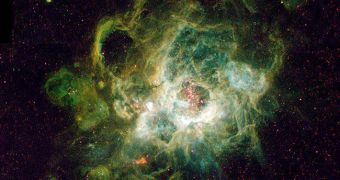One of the last great standing mysteries in astronomy is galaxy and star formation. Experts are disassembling the issue in its components, and are currently focusing on what controls the formation of new stars. This work has recently made important progress.
The rate at which new, blue stars form in essential for the growth of the celestial fireballs' galaxies as well. Most of this growth, astronomers say, originates inside specialized nebulae called stellar nurseries, which dot the arms of younger galaxies.
Old and massive ones, such as the Milky Way, no longer produce large amounts of stars, even if a decent number is still being created inside their own nurseries, PhysOrg reports.
Experts realized some time ago that these nebulae do not exist independently of the structures they reside in, and have take an interest in determining all the factors that influence stellar formation.
At this point, the main theory that explains how new suns appear is pretty straightforward. Nebulae are basically made up of cosmic dust and hydrogen gas, the main ingredients for creating stars.
As massive clouds containing these two elements meet, they tend to come together around a single center of gravity. Inside the clouds, hydrogen atoms connect into molecules, usually around a spec of dust, that acts as a condensation nucleus.
Eventually, the clouds grow so big and massive, that they collapse under their own weight. As this happens, the gas masses experience massive amounts of friction among themselves. If the temperatures produced are high enough, the mixture catches on fire.
This fire is in fact a thermonuclear fusion reaction, that ignites the collapsed clouds into a protostar, which then begins to accrete even more mass from its surroundings.
But astronomers have always wondered as to the nature of the factors that influence the pace at which each nursery produces its stars. Smithsonian Astrophysical Observatory astronomer Charlie Lada led a team that investigated this issue in detail.
The experts looked at 1 stellar nurseries located nearby, and published the results of their research in the latest issue of the Astrophysical Journal.
All stellar nurseries in the study were different from each other, especially as far as their mass went. The smallest one weighed some 800 solar masses, while the largest was a whooping 100,000 solar masses.
The team was surprised to learn that the size and mass of the stellar nursery could not be directly linked to the number of new star formed, or to the rate at which these stars developed.
Some of the least massive nurseries in the study exhibited the highest rate of stellar formation, the researchers explain. The California Nebula, the largest in the study, had among the lowest production rates.

 14 DAY TRIAL //
14 DAY TRIAL //